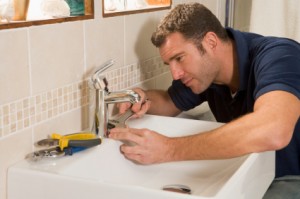Bathroom remodeling, the right way!
Whether you just want to replace the builder grade fixtures and vanities or completely gut and renovate your bathroom, we have the services for you.
If your home is from one to ten years old, it is very cost effective to replace your builder grade vanities, fixtures, mirrors, etc. Keeping the existing plumbing and electrical in place saves you a great deal of money and still allows for updating. Some of the most common bathroom renovations of this type include new tile, vanities, light and plumbing fixtures, trim and paint. Waterproof membranes behind the new tile and proper ventilation along with quality fixtures are the most important things to consider.
If your home is older or you would like more extensive bathroom remodeling, then we want to completely gut the bathroom to start fresh and make sure that everything is done correctly. We want to make sure that the plumbing and electrical is up to date, and that there are no mold or moisture problems. We correct mold and moisture issues by using waterproof membranes behind the tile, properly insulating the bathroom, proper ventilation, and making sure that everything is caulked and sealed.
Waterproof membranes such as DITRA are extremely important to ensure that there are no moisture problems in the shower or bath area. Ditra is also important under the tile floor to prevent tiles from cracking.
The bathroom renovation process
Step one: The first step of your bathroom remodeling project is planning and design. During a renovation, anything is possible. Depending on your needs, you may want to rearrange the locations of plumbing or lighting fixtures, add fixtures and storage space. If there is room, you may even want to expand.
Step two: Permits. Unless you are just replacing fixtures and tile, permits and inspections are always required. Bathroom remodeling projects generally require three - Structural, plumbing, and electrical. Don't do a remodel project without them.
Step three: Removal. The best way to see if there are any moisture or mold issues is to remove everything, right down to the studs. We also want to check the plumbing and electrical to ensure that it is up to date and correct. We also want to check the framing and structure of the bathroom.
Step four: Plumbing. If the layout of the bathroom is being changed, then the plumbing feed lines and drains will need to be moved at this time. If you have an older home with cast iron drains or galvanized steel pipes, then they will need to be changed and brought up to standards.
Step five: Electrical. If you have an older home, then you will need to have GFCI outlets in the bathroom. GFCI outlets have their own breaker that protects you from shock. If you are changing or adding lights or outlets, then it will be done at this time. Consider adding lighting, switches, and outlets.
Step six: Ventilation. This goes with electrical, but it's so important that it's it's own category. Minimum code requires that you have at least one window or vent in your bathroom. Preferably both. Proper ventilation prevents mold or moisture problems. Keeping the air dry also makes the bathroom more comfortable. We can install vent fans that have humidity sensors, lights, and nightlights.
Step seven: Framing. If you live in an older home or have a second story bathroom, then we have to make sure that there is proper support for the tub. If the wood floors are not strong enough or they flex, we can correct the issue to make the floors stronger. This is also a good time to make sure the walls are properly insulated. You may also want to add soundproofing.
Step Eight: Tile. As I mentioned earlier, an underlayment such as DITRA is critical, because it is the only thing that is waterproof behind your tile. DITRA also prevents any cracking on floor tiles. Bathtub and shower areas should have a concrete backerboard before the tile. The rest of the bathroom can have green moisture resistant drywall. When choosing tile, consider a tile floor with a non-slip surface. With tile installed correctly and caulked in the right places, your bathroom will last a lifetime.
Step nine: The final fixtures and finishing touches. Always go for better fixtures and products in your bathroom. They will last a lot longer and will perform much better. It's always worth the money. It's also time to paint and do any trim and final caulking and clean up.
The most important step: Call Earley Construction Inc. for a free estimate or for any questions 904-207-0255
Thank you.
Get in Touch
